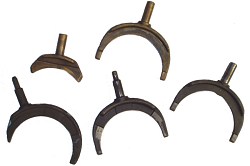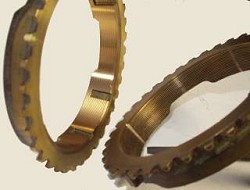HISTORY OF THE A-833 CHRYSLER FOUR SPEED TRANSMISSION
Chrysler’s first factory-installed four-speed transmission (1963) was the Borg Warner T-10. It didn’t take long for the engineers at Chrysler to conclude a stronger and more durable transmission was needed, and the A-833 was introduced with the 1964 model year.The transmission was designed by Chrysler and manufactured by New Process Gear Co. Both ’64 and ’65 models carried the flanged output for the ball-and-trunnion style universal joint. B- and C-bodies utilized the common 2.66 low gear ratio, while the A-body transmissions were 3.09 low gear ratio. The 1965 Super Stock 426 Hemi-powered vehicles received the first heavy duty “Hemi” 18-spline input models.
The flange-style output was dropped for the 1966 models, and the slip-yoke tailshaft was introduced. The long tailshaft versions utilized the larger 30-spline output shaft (same as the 727 Torqueflite) and the short tailshaft version the 26-spline output shaft (same as the 904 Torqueflite). The production of the 1967 383 big block-powered Darts and Barracudas mandated the addition of the 30-spline output shaft in the A-body transmission, which was expanded to include all A-body transmissions in 1968.
Beginning with the ’68 models, a small (3″ X 7/8″) raised machined pad was added to the main case, just above the casting numbers on the passenger’s side. The car’s serial number, along with the transmission’s build date (10,000 day calendar code) and a 4-digit sequential production number are stamped into this pad.
With the 1970 models, the new “lug-style” synchronizer rings and the wider (.382″ vs .216″) synchronizer struts were introduced. Production of the AAR Cuda and T/A Challenger Trans-Am models in the spring of 1970 introduced two major changes in the A-833, the first being the 2.47 low gear ratio (or “close ratio”) and the replacement of the tried and true ball-detent side cover with the interlock lever design. 1971 18-spline transmissions also received a gear change with a similar 2.44 low gear ratio gearset.
1974 ended the long tailshaft B- and E-body 4-speed production, while 1975 was the last year for the A-body short tailshaft 4-speed and the beginning of the overdrive versions of the A-833. The 23 year run of the famous A-833 ended with the 1986 model Dodge trucks.
Chrysler installed the 833 four speed behind the Slant Six at two different times. The first production four speed slant sixes were the 1964-66 A-body four speed cars. The second run of production four speed slant sixes began in 1975 with the release of the Overdrive A-833. From 1975 until 1987 the Overdrive four speed was installed in slant six applications of A-bodies, F-bodies, and light trucks (D100 & D200 series trucks).
Strength Considerations
Chrysler engineers decided that Hemis required a beefier input shaft so the standard 23-spline shaft was replaced with a beefier 18-spline unit and a larger input bearing was used to accept the additional torque. Later Chrysler decided that the high performance 440s needed this beefiness as well. It is one of a few aspects that set the “Hemi” four speeds apart from the standard 4.35″ A-833s as being extra beefy. As far as strength is concerned, outside of the input shaft, the input bearing, the retainer and some special gear sets, there were no additional measures added to A-833s for Hemis. In the Sixties the only other difference between a Hemi A-833 and a Slant Six A-833 were the gear ratios used. The Slant Six 4-speed is just as beefy as the Street “Max Wedge” V-8 units.
|
|
For the passenger cars, Chrysler manufactured two different length four speeds. The A/F-bodies received a short tailshaft A-833 and the B/C/E-bodies received a long tailshaft A-833. This difference is obvious when one of each type is sitting side by side, but either type is easily identified when it happens to be a standalone unit. The short A/F-body tailshaft places the shifter pad behind the cross member mounting flange. (The shifter mount is the 3 bosses set in a triangle shaped
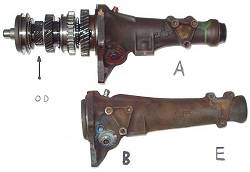
pattern on the side of the tailshaft and serves as the mount point for the shifter). The cross member mount flange is the 2 bolt pad on the bottom of the tailshaft that serves as a mount point for the cross member). A/F-body 4 speeds have only one shifter pad. The 1964-1969 B/C-body A-833s place the shifter pad ahead of the cross member mount flange, and the 1970-74 B/E-body long tail housing four speed has two shifter pads, one ahead of the cross member mount flange (for B-bodies), and one behind the cross member mount flange at the very end of the longer B/E tailshaft housing (this position is used in E-bodies). It is possible to use the B/E transmission in an A-body, which is done by fabricating an adapter that is shown below
. 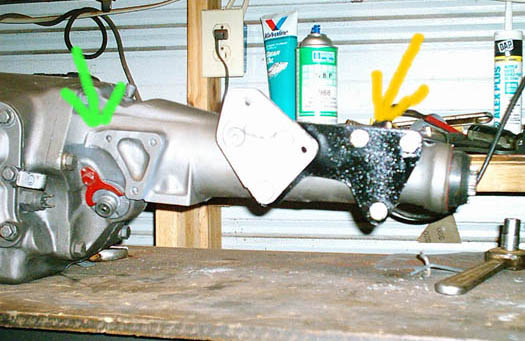
Gear Ratios
There were at least six different gear sets used in production 833 four speeds. Below is a list of the most common gear sets:
|
SPLINE
|
1st
|
2nd
|
3rd
|
4th
|
1st |
2nd |
3rd |
4th |
|
Small |
2.66(35) |
1.91(34) |
1.39(29) |
1.00(24) |
17 |
23 |
27 |
31 |
|
Small |
2.47(35) |
1.77(34) |
1.34(29) |
1.00(25) |
17 |
23 |
26 |
30 |
|
Small (/6) |
3.09(35) |
1.92(32) |
1.40(27) |
1.00(22) |
17 |
25 |
29 |
33 |
|
Small (1975+ /6 OD) |
3.09(35) |
1.67(30) |
.73 (18)Flipped |
1.00(22)Flipped |
17 |
27 |
37 |
33 |
|
Large |
2.65(33) |
1.93(30) |
1.39(26) |
1.00(21) |
16 |
20 |
24 |
27 |
|
Large |
2.44(33) |
1.77(30) |
1.34(26) |
1.00(22) |
16 |
20 |
23 |
26 |
Large
(Hemi Red Stripe) |
2.65(33) |
1.64(28) |
1.19(24) |
1.00(21) |
16 |
22 |
26 |
27 |
Bellhousings
Below is a chart of Big Block Bellhousings. The 10.5- inch clutch housings seem to be the easiest to use for swaps into an A-Body.
The 11 inch Bellhousings are usable in the A-body as well, but will require linkage modifications.
Slant Six owners have two bell housing options to mate G/RG blocks to 833s. The original 1964-66 Slant Six four speed bell housing is a great candidate and accepts any A-833 with a 4.35″ IBR profile. These units were all cast iron. While these bell housings are becoming increasingly hard to come by, the inspection plate, dust shield, clutch fork, and fork boot can all be swapped-over from a Sixties G/RG with an A-903 three speed. The casting numbers for the early cast iron bell housings are 2463025, 2463027, and 2468431.
A much cheaper and plentiful bell housing to use is the 1975-81 A-833 Overdrive Slant Six bell housing. The upshot of this bell housing is that it is cast aluminum, the downside is that it only accepts A-833s with 5.125″ IBR profiles. When looking for donor vehicles in salvage yards, don’t’ walk past late seventies slant six three speed cars. Chrysler used the same bell housing for both A-833 Overdrives and three speeds by placing both bolt patterns on the same bell housing. A casting number for this bell housing is 3743645. (This is a 1975 number, no doubt later bell housings used other numbers.) The Overdrive bell housings use a unique clutch fork mount that you will not find on regular three speed or four speed bell housings. Make sure you keep track of the correct fork and its mounting stand that bolts inside of the bell housing!
|
Mopar Big-Block Bellhousings |
|
Casting Number
|
Bellhousing
|
Year(s)
|
Application
|
Material
|
|
2182351
|
10-1/2″ clutch A-833
|
1964
|
B-body 361 383 413
|
Cast Iron
|
|
2206044
|
A-833
|
1964
|
B-body 426 III
|
Steel
|
|
2406042
|
10-1/2″ clutch A-833
|
1964
|
B-body 426 III
|
Steel
|
|
2406043
|
10-1/2″ clutch A-833
|
1964
|
B-body 426 III
|
Steel
|
|
2406292
|
10-1/2″ clutch A-833
|
1963
|
B-body 361 383
|
|
|
2406293
|
10-1/2″ clutch A-833
|
1963
|
B-body 361 383
|
|
|
2463017
|
11″ clutch A-833
|
1964
|
B-body 361 383 413 426
|
Cast Iron
|
|
2463019
|
11″ clutch A-833
|
1964
|
B-body 361 383 413 426
|
Cast Iron
|
|
2463235
|
10-1/2″ clutch A-833
|
1964-1965
|
B-body 426 HEMI
413-426W
|
Steel
|
|
2463236
|
10-1/2″ clutch A-833
|
1964-1965
|
B-body 426 HEMI
|
Steel
|
|
2468370
|
10-1/2″ clutch A-833
|
1965-66
|
B-body C-body 361 383 413 426
|
Cast Iron
|
|
2468372
|
10-1/2″ clutch A-833
|
1965-66
|
B-body C-body 361 383 413 426
|
Cast Iron
|
|
2536106
|
10-1/2″ clutch A-833
|
1965
|
B-body 426
|
Aluminum
|
|
2536945
|
10-1/2″ clutch A-833
|
1966-1969
|
A-body B-body C-body 361 383 440
|
Cast Iron
|
|
2692259
|
11″ clutch A-833
|
1968-1969
|
B-body 426 HEMI
|
Cast Iron
|
|
2780510
|
11″ clutch A-833
|
1966-1967
|
B-body 426 HEMI
|
Cast Iron
|
|
2780512
|
11″ clutch A-833
|
1966-1967
|
B-body 426 HEMI
|
Cast Iron
|
|
2843234
|
11″ clutch A-833
|
1967
|
B-body C-body 440
|
Cast Iron
|
|
2843235
|
11″ clutch A-833
|
1967
|
B-body C-body 440
|
Cast Iron
|
|
2892257
|
11″ clutch A-833
|
1968-1969
|
B-body 426 HEMI
|
Cast Iron
|
|
2892260
|
11″ clutch A-833
|
1968
|
B-body C-body 383 440
|
|
|
2892262
|
11″ clutch A-833
|
1968
|
B-body C-body 383 440 4.80″ IBR (cast dates include 9/5/67 10/20/67)
|
Cast Iron
|
|
2892624
|
B/RB 11″ clutch A-833
|
1969
|
B-body C-body 383 440
|
Cast Iron
|
|
2892511
|
A-833
|
1970-1974
|
B-body E-body 383 400 426 440
|
Aluminum
|
|
2892513
|
A-833 10.5 clutch
|
1970-1974
|
B-body 383 400 426 440 E-body
|
Aluminum
|
|
2892626
|
11″ clutch A-833
|
1969
|
B-body C-body 383 440
|
Cast Iron
|
|
2899104
|
A-833 383 440
|
1969-1971
|
Truck
|
Cast Iron
|
|
2899105
|
A-833 383 440
|
1969-1971
|
Truck
|
Cast Iron
|
|
2902260
|
440 B-body A-833
|
1968
|
|
|
Bearing Retainer Considerations
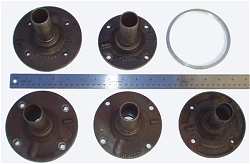
|
Bearing Retainer Diameters
|
|
Bolt Circle |
Diameter |
Application |
Retainer |
Input Bearing |
|
3.70 |
4.354 |
A-body, all years except 1968 Big Block and Overdrive units,
All Small Block 1970 and later 23 spline units. 1.248 tube diameter. |
P4529694 |
P4529698 307
Small Bearing #307 3.14″ OD |
|
3.70 |
4.354 |
1966-1967 18 spline units. 1.417 tube diameter. |
|
P4529698 307
Small Bearing #307 3.14″ OD |
|
3.70 |
4.807 |
1968-1969 Big Block 23 spline units. 1.248 tube diameter. |
P4529695 |
P4529699 308
Large Bearing #308 3.54″ OD |
|
4.16 |
4.807 |
All 23 spline Big Block units (383-400) 1970 and later.
1.248 tube diameter. |
P4529696 |
P4529699 308
Large Bearing #308 3.54″ OD |
|
4.16 |
4.807 |
All 1968 and up 18 spline units. 1.417 tube diameter. |
P4529698 |
P4529699 308
Large Bearing #308 3.54″ OD |
|
4.16 |
5.125 |
All OD A-833 units. 1.248 tube diameter. |
|
Came with both bearings
(initially the 307, changed to the 308) |
The Input Bearing Retainer (or IBR) that is located on the front of the four speed and fits into the large hole in the back of the bell housing. There were three different sizes on production four speeds. There was the 5.125″ diameter IBR used on the 1975 and later Overdrive units, the 4.80″ diameter IBR used on “Hemi” transmissions, and a 4.35″ diameter IBR used on almost everything else. Be aware that the 4.80 retainer is not exclusive to the 18-spline transmission, as some heavy-duty 23-spline units used it as well. The 4.80″ IBR “Hemi” units are also known for their special “coarse cut” gears, 18-spline input shaft (or “Main Gear Drive” as it is referred to in parts manuals and factory service manuals), larger input bearing, and the requirement of a larger clutch release bearing. Calling it a “Hemi” unit is not entirely correct, as the18 spline units were also used in most 440 applications as well. “Hemi” units are rare compared to the regular 23- spline four speeds, however there are generally a few floating around at most major swap meets. For the “early” 1964-1965 A-833s, both the A-body and the B/C-body units used the ball & trunion output flange type. All later (66 & up) A-833s were slip yoke types. Also be aware that the 1966-67 A-body 4-speeds and some mid -70’s A-/F body overdrive units used the small (904 size) output shaft and slip yoke. The “ball & trunion” 4-speeds are easily identified by the four-bolt non-sliding flange attached with a large nut on the end of the thicker cast iron tailshaft housing. The larger tail housing allows room for a third ball bearing at the rear of this 833, making it a very strong and stable gearbox. Even with this added bearing, this transmission should probably be avoided by anyone who doesn’t have a 1965 or earlier car or isn’t prepared for the challenge of shortening a ball & trunion drive shaft or locating the “getting hard to find” ball and trunion replacement parts.
The Overdrive bell housings can be modified to accept either the 4.80″ or the 4.35″ IBR. A ring must be fitted to the bell housing to reduce its IBR hole from 5.125″ to 4.35″ or 4.80″. This ring must maintain the hole’s exact center! A skilled and caring machinist should be able to accomplish this without issue. Good planning would provide the machinist with the bell housing and IBR you plan to use so a perfect fit can be achieved.Once upon a time Chrysler made IBRs that fit the standard 23-spline case and mated to the 4.80″ and 5.125″ bell housings, however these appear to have been discontinued and snatched up a while ago. An additional option for someone trying to put a close ratio 4.35″ IBR A-833 behind an Overdrive bell housing is to use an Overdrive front case and IBR and replace all the internal parts with those from a closer ratio four speed. This swap requires changing all gear sets, shafts and the countershaft.
Z-Bars and Linkages
The factory linkage combination for Big-Block A-bodies was unique to this application. The Z-Bar, ball-stud and bracket and spacer that attach to the bellhousing are all Big-Block specific A-body parts. The diagram below shows its correct assembly.
|
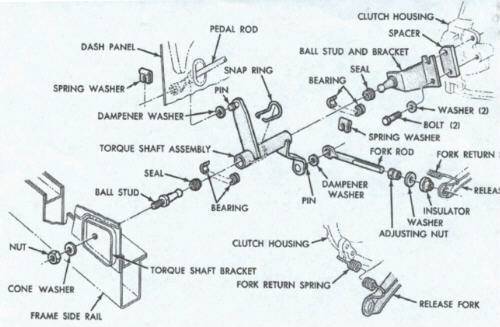
|
|
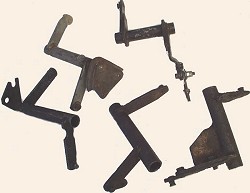
A body: PN# P4529-447 B/E body: PN# Seals: 2265-942 Bushings: 2265-938
Clutch Rod Kit P4529448 Clutch Fork Kit P4529451
|
|
Clutch And Brake Pedal Combos |
|
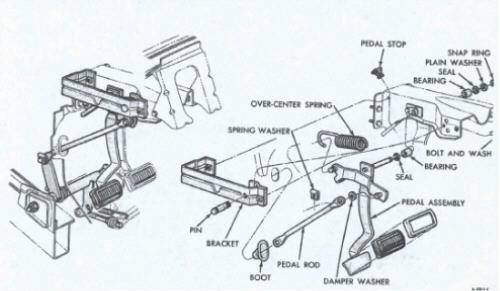
Fortunately, this is one of the easier aspects of this swap. A large percentage of our beloved A-bodies were equipped with the slant-6, Three-on-the-tree combo, making clutch and brake pedal combos one of the easier A-body parts to find. This assembly is a bolt-in swap for an automatic car, as all necessary holes, etc. are already provided from the factory. Also, they remained basically unchanged from 1967-1976. A stiffener plate, (Torque shaft bracket) shown below, is also welded to the outboard driver’s side frame rail just behind the front suspension area. This provides a rigid mounting area for the Z-bar pivot ball. As long as you’re swiping the clutch/brake pedals, you’ll need to grab this plate as well.
|
|
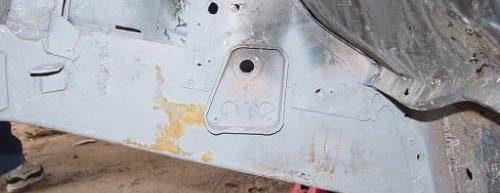
|
|
Crankshafts, Flywheels, Pilot Bearings, Etc.
In the past, one of the major showstoppers in this conversion was the crankshaft register. Crankshaft registers need to be machined properly to accept the input shaft pilot bushing for the A-833, and a majority of the time, they were only machined to accept the hub of the torque converter for an automatic transmission application, or were only partially machined for the input shaft bushing. Your choices were either to have the crankshaft machined properly, ($$$$) or stick with your automatic. In the case of cast crankshafts, I’ve heard horror stories of drilling into oil passages when attempting the machine work! (If anyone can verify this, please let me know.) Fortunately, in 1994, Ma Mopar accidentally offered us an alternative- Beginning with the ’94 model year, Chrysler began machining the crankshaft registers only in the “Automatic” configuration. Manual transmission applications received a new, needle-type bearing, which fit into a larger bushing that is driven into the torque converter register. The good news is that the torque converter register remained the same size as it has been since the mid-sixties! The bad news is that in most applications, the input shaft will need to be shortened approximately from 1/2-3/4 inches. This is an easy job with a cut-off wheel, but it could diminish the re-sale or trade value of your transmission should you decide to part with it. This part is available at most parts houses.
(BCA #FC69907, or Mopar # (53009180AB).
|
|

An automatic transmission crank register, not fully machined for the A-833 input shaft
|
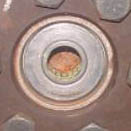
The same crank register with the BCA #FC69907 bearing installed.
|
Sheet Metal
|
Four speed cars require a special floorboard hump alongside the trans tunnel to clear the shift rods and the shifter. This is because the floor shift linkage runs over the top of the torsion bar / trans mount cross member, basically through an area thntly part of the passenger compartment of an automatic car. From the factory, these floor humps were stamped steel pieces that were welded to the regular floorboard after an appropriately sized hole was cut out of a common floor pan. Any automatic to four-speed conversion will require cutting a hole and adding a hump extension. The hump’s size and shape varied from platform to platform as well as year-to-year in some cases. Depending on the year and platform of the car, you will either have to procure an original hump cut from a donor car or find a fiberglass or steel reproduction. For the A-bodies, the OEM stampings changed at least four times as follows:
1964-65 round hole for shifter.
1966 hump is the same as 1964-65, except an oblong shifter hole is used.
1967-74 available as a fiberglass reproduction, as well as a new stamped steel piece.
1975-76 similar to the 1967-74 floor humps.
|
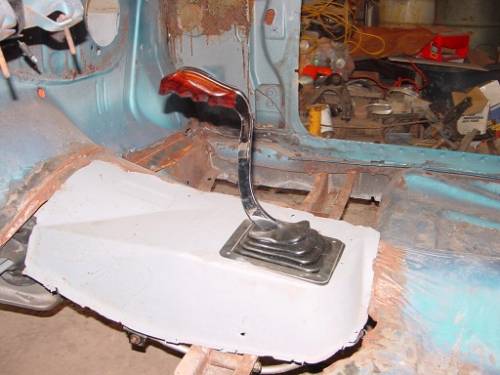 |
|
Shifters
All Chrysler A-833s were equipped with Hurst shifters with the exception of the Inland shifter debacle of 1966-1968. The Inlands are pretty recognizable (they don’t look like Hurst shifters!) and I believe the Inland-Chrysler relationship was rekindled in the Seventies with the Chrysler floor shift A-body and E-body three speeds. A nice feature of an Inland shifter is that it has a pull-up reverse lockout lever. Enough talk about Inland, the Hurst units are the ones to have! There was a huge variety of OEM Hurst shifters built
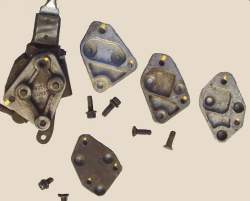 It is important to point out that there is a shifter mounting plate or “adapter” which goes between the transmission’s 3-bolt shifter mount and the 2-hole shifter “box”. There are many different adapter plates used for different chassis. The shifter adapter plate will angle the shifter lever and has an effect on shift rod lengths. There are many variations over the years and needless to say, you need the right ones for your setup. Shifter linkage rod length changed between the different platforms (A, B/C, and E bodies) as the adapter plate / shifter was placed at different locations along the tailshaft. Additionally, the A-body Overdrive A-833s used a different 3rd-4th rod to accommodate the up-side-down shift operating lever. On top of all that, the hole in the lever that the linkage rods fit into changed in diameter at some point during the four speed shifter years.
|
Flywheels, Clutches, and Clutch Linkage (Slant 6)
For bell housing clearance reasons, the small 124 tooth flywheel must be used on both the 1964-66 bell housing and the 1975-81 Overdrive A-833 bell housing. Larger 130 tooth and 143 tooth flywheels do not fit these bell housings (the starter will not engage ring teeth). When locating a flywheel, be sure that the center hole matches your crank’s register hub. A 1963-67 flywheel must be used with a 1963-67 crank and a later flywheel must be used with a later crank. (Measure your crankshaft hub.)While the 124 tooth flywheel is very common (used on all passenger car slant six manual transmission applications) and generally dirt cheap, its size limits clutch options significantly. Over the counter clutch options include the original Borg and Beck 9-1/8″ and 9-1/4″ clutches. Over the years the pressure plates for these clutches were manufactured with various spring weights. There is a heavy duty 10″ truck clutch that does fit, however special attention needs to be paid to the clutch linkage as the heavy weight of the clutch’s springs can cause failure in the stock clutch linkage system.
|
OD A-833 Behind A Big-Block – (or small Block)
Chrysler’s OD A-833 was introduced in 1975 to replace the standard A-833. With the energy crunch of the early 1970’s in full swing, the performance oriented A-833 was laid to rest. The Overdrive four speed was basically a regular A-833 with an overdriven gear set installed in place of the regular third gear. The shift lever on the side cover was flipped over to “fool” the shifter into shifting from second to fourth and then back into third, which was the overdrive gear. The overdrive gear is very small and as a result, the mainshaft journal and splined hub is smaller. This results in a unit that it not quite as tough as the A-833, but in a medium horsepower street driven vehicle, it should prove to be a sufficient unit. You can swap OD 833 parts as a set into the correct case for the mainshaft. Ma Mopar never offered the OD A-833 behind a Big-Block, but it can be accomplished in a few different approaches. One alternative is if you are lucky enough to have a bellhousing that accepts the 4.80 bearing retainer. In this case, you could simply purchase a 4.80 diameter/3.70 bolt circle-bearing retainer designed for the 23-spline input transmission. (These can currently be purchased from Passon Performance. With this combination, it is a bolt-together swap. Unfortunately, 4.80 retainer diameter bellhousings aren’t exactly falling out of the sky, but there is another alternative-Below are the steps needed to adapt the OD A-833 to a #2468372 casting, 4.35 diameter retainer bellhousing.
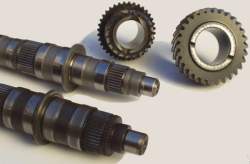
The Overdrive four speed was a regular A-833 with an overdriven gear set installed in place of the regular third gear. The shift lever on the side cover was flipped over to “fool” the shifter into shifting from second to fourth and then back into third, which was the overdrive gear. The overdrive gear is very small and as a result, the mainshaft journal and splined hub is smaller. You can swap OD 833 parts as a set into the correct case for the mainshaft.
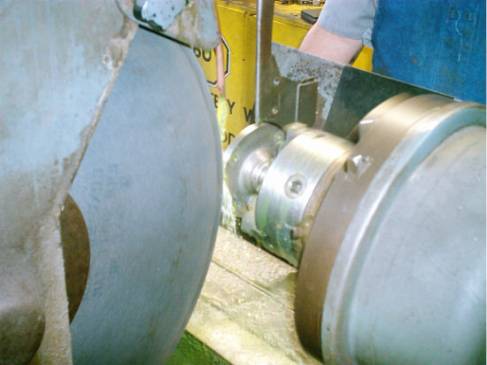 First, the 5.125 bearing retainer is mounted into a crankshaft lathe and is ground to the appropriate 4.80 diameter
|
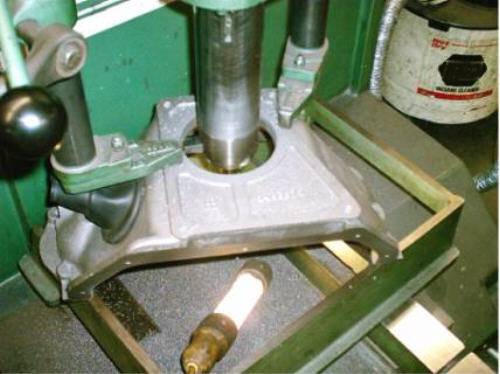
Next, the bellhousing is bored to 4.80 |
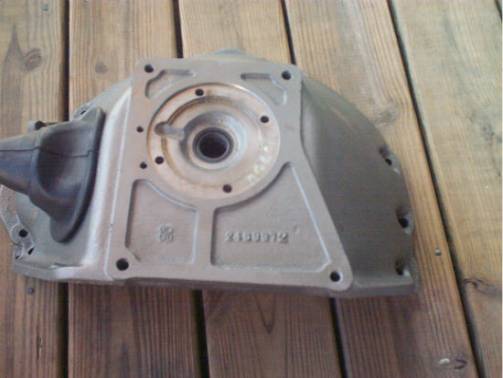
The result is a perfect fit! |
Keep in mind that this was done using bellhousing casting # 2468372. I’m certain other bellhousings could be used, but care must be taken that the clutch fork retainer mounting holes aren’t weakened when the bellhousing is bored
Headers, Exhaust Manifolds
As far as exhaust manifolds are concerned, the only ones useable without modifications are the factory Big-Block A-body units. B-body HP manifolds can be used, but will require Z-bar relocation. (See picture below.) From what I’ve been told, the Schumacher Tri-Y headers fit well with no mods needed, as do most fenderwell headers.
|
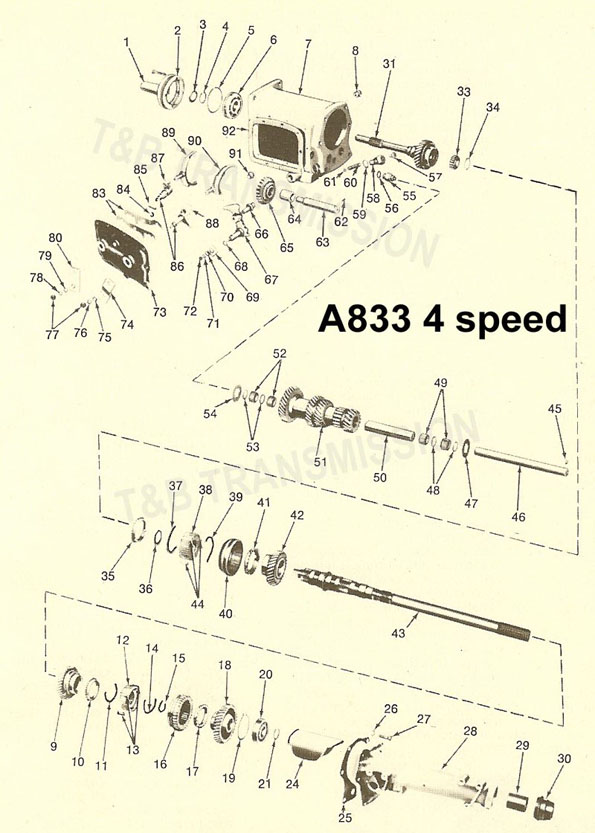 |
|
|
Clutch / Flywheel
The general sizes are listed below:
/6 = 10″ or 9 ¼”
318, 340, 360 = 10.5″
360 = 10.5″, 11″
Externally balancedThis engine requires an externaly balanced 10.5″ flywheel. This wheel was only made in 1974 in limited production. If you ASSUME you can use a flywheel out of a 360 van you will be sorely disappointed. It does not fit in the standard 10.5″ bellhousing!!! It is an 11″ wheel so beware. Unless you buy an 11″ housing to make it fit. You can use an 318 wheel and drill three balance holes in the rear of it. Mopar has re-released the 10.5″ 130 tooth 360 cast iron wheel, PN# P4529110 (Magnum 360 is PN# P5249842)
AUTOMATIC
A-727
Introduced in 1962. It is a 3 speed unit with a slip spline output shaft for the years 1965+. This transmission came behind most performance small blocks (340 & 360) and all big blocks (361, 383, 400, 440, 426 Hemi). There is a difference between the small block and the big block cases so they do not interchange.
A-904, 998 ,999
The 904 is a light duty version of the 727 and is smaller in size and lighter in weight. It was used mainly with the /6 and 273 engines. The 998 is a heavier duty version designed for the 318 engine. The 999 is the heaviest of the 904 type transmissions and was used behind 360 engines in 1974 – 1979. The drive shaft yoke on the 904 series transmissions is smaller than the 727 so they are not interchangeable. The length is also shorter than the 727 so if you want to swap in a 727 for your 904 drive shaft shortening is necessary.
Transmission speedo pinion chart:
On Tom’s moparts and other sites there are speedo pinion charts for you to select the proper tranny gear for your rear end axle / tires to keep that speedo reading correctly. These pinion suggestions can be found in early Mopar chassis manuals but are omitted in the later ones. The pinion part numbers found on Tom’s site is outdated but can be cross-referenced by your Mopar dealer. They all have been revised which probably explains why the Mopar chassis manual dropped the pinion/gear/tire chart as they didn’t want to go throught the work of updating it. Here are the most recent numbers that I can find:
|
TOOTH |
COLOR |
PN# |
|
24 |
WHITE
|
3410024
|
|
25
|
BLUE |
3410025 |
|
26
|
RED
|
2538926
|
|
27 |
WHITE |
52068149 |
|
28 |
BLUE |
52068150 |
|
29 |
BLACK |
52068151 |
|
30 |
YELLOW |
52068152 |
|
31 |
GREEN |
52068153 |
|
32 |
BLACK |
52068154 |
|
33 |
YELLOW |
52068155 |
|
34 |
GREEN |
52068156 |
|
35 |
ORANGE |
52068157 |
|
36 |
RED |
52068158 |
|
37 |
WHITE |
52068159 |
|
38 |
BLUE |
52068060 |
|
39 |
GREEN |
52068061 |
|
40 |
ORANGE |
52068062 |
|
41 |
RED |
2538941 |
|
42 |
WHITE |
2538942 |
|
43 |
BLUE |
2538943 |
|
44 |
? |
? |
|
45 |
? |
? |
The speed drive mechanism and gear from the 3 speed swapped directly into the OD 4 speed
A few things I must note. I have a few of the old 253XXXX and 341XXXX numbers up there in red. This is because they are supposedly discontinued With the old numbers it used to be easy to find out the tooth count as the last two numbers of the part numbers were the number of teeth (i.e. 2538943 = 43 teeth). Today Mopar has made everything more difficult and this is no longer the case.
The pinions spin inside an adaptor housing that fits into the transmission housing. There are two adaptors, PN# 2892994 (discontinued) & 2538608. The 994 is only used for the 24 & 25 tooth pinion, the 608 is for all others. If you are going through all of the trouble to change pinion gears do yourself a favor and buy a new seal kit for the adaptor PN# 4883434AA. If this thing leaks you will have tranny fluid coming out everywhere (including the back of the speedometer) and you will have go back in and fix it.
Torque converters:
360 Torque converter balance kit part number: P4120241.
360 Magnum Torque converter balance kit part number: P5249843
|

















